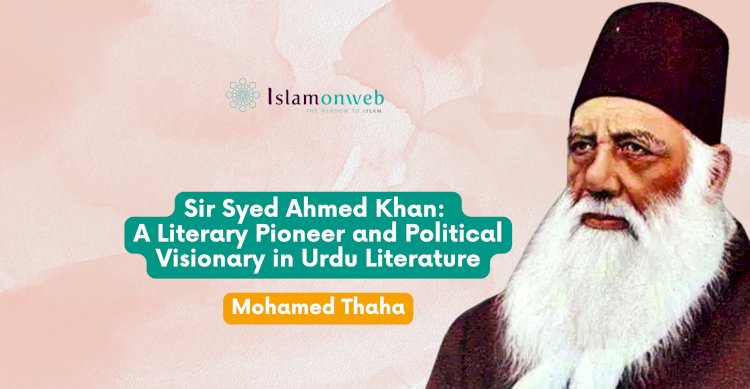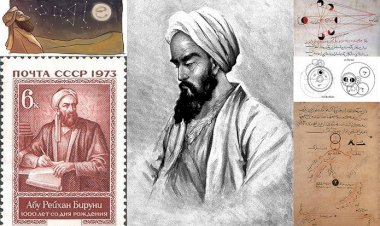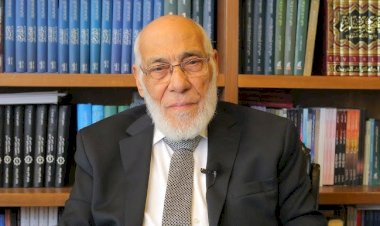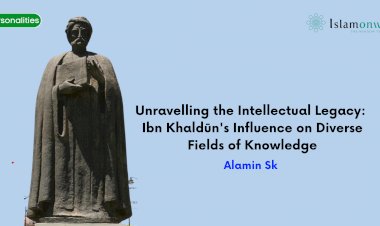Sir Syed Ahmed Khan: A Literary Pioneer and Political Visionary in Urdu Literature
Sir Syed Ahmed Khan was a remarkable figure in the history of literature and a prominent thinker in the world of Muslim nationalism. He embarked on his literary journey at a time when the Urdu language had not yet been widely written. His contributions to literature were extensive and influential, marking significant milestones in the development of Urdu literature.
Before the Indian War of Independence in 1857, Sir Syed Ahmed Khan authored numerous works, including historical texts like A'in-e Akbari, Aasarus Sanadid, Jam-e-Jum, Tarikh-e Firoz Shahi, and biographical works such as Al Khutubatu Ahmediyya and Tuhfa-e Hasan. He also delved into political writings, discussing important topics like the causes of the Indian revolt in works like "Asbab-e-Baghawat-e-Hind" and critiquing Hunter's views on Indian Muslims in "On Hunter's: Our Indian Musalmans." After the war of independence, his literary contributions continued to evolve, leaving a lasting impact on the Urdu language and the intellectual landscape of India. It would be worth noting how deep Sir Syed Ahmed Khan's literary contributions are, when it comes to take account of the two distinct phases before and after the 1857 War of Independence.
Works Before the Independence War of 1857
Before the Independence War of 1857, Sir Syed Ahmed Khan's literary contributions covered a diverse range of religious topics and historical subjects. In his extensive body of work, he explored the Mughal Empire through texts like "Jam e Jum," offering concise insights into this historical period. He delved into matters of public law with "Intikhab Al Akhwayan" and contributed to the understanding of Islamic history with "Jila Al Qulub ba Dhikr Al Mahboob," which provided a brief account of the birth of Prophet Muhammad ﷺ. Furthermore, Sir Syed translated "Tuhfa e Hasan" from Shah Abdul Aziz Dhalawi's renowned work, "Tuhfa e Ithna Ashariyya," enriched Urdu literature. Additionally, he presented an Urdu edition of a Persian translation from Arabic, "Risalah Tashil fi Jarr-e Thaqil," shedding light on the life of Abu Dharr Yemani. These works laid the foundation for his enduring literary legacy and demonstrated his multifaceted engagement with various aspects of knowledge and culture. Among his major works are:
Aasarus Sanadid
The first book written by Sir Syed Ahmed is Aasar-us-Sanadid which was published in 1847 when he was 30 years old. This book enlightened the culture of India. He divided this book into four sections, which majorly revolves around: 1) Detailed Description of the edifices outside Delhi; 2) Description of the edifices around the Delhi Fort; 3) Outline of the beautiful monuments in Shahjahanabad; and 4) Historical settlement of Delhi. The description of the book contains the details about the Sufi Saints of Delhi, i.e. Sayed Ahmed Shahid and Gulam Ali Shah, and the scholars, Poets and Musicians who passed in Delhi. The second edition of this book was published in 1854. While the second edition was totally different from the first one, this great contribution was translated into French by Gracin de Tassy in 1861.
Tarikh e Firoz Shahi
This is an Indo-Persian historiography written during the Sultanate age in India by Zia Ad Deen Barani. Later this book was taught in Aligarh Muslim University. Sir Syed Ahmed had edited the Persian text of this book and it was published in Kolkata.
Works After the Independence War of 1857
Sir Syed Ahmed felt that the upliftment of Muslim community can only be possible with modern education. One of the major grounds that led him to come to this conclusion is the backwardness of Muslims regarding western principles, particularly the English language. Thus, realizing the need of the hour, he started his works based on the Western education system. He guided the community with his different approaches and works. His books after the war were written to help the Muslim community and remove the gulf between the Muslims and Christians as well as to make a bond between the British. Some of his major works include:
Sarkashi-e-Zila Bijnor
This was a small piece of writing by Sir Syed Ahmed which not only developed the Muslim nationalism, but also described the history of the mutiny of Sepoys during 1857. This was the first book to explain the Mutiny in Urdu Language.
Risalah Asbab e Baghawat e Hind
This was the first efficacious booklet written in Indian Language to express the educational backwardness and economic issues of India. This was published in 1858 and the copies were sent to the parliament of London. Later this was translated to English Language and named as “The Cause of Indian Revolt”. This piece of work became a separate way for the identity of Muslims in India.
The Loyal Mohammedan of India
A short brochure which helped Muslim community during the protest against the British in the year 1860. Sir Syed Ahmed published this journal to draw the true sketch of loyal Muslim families who helped the British during the war of Independence. He made the translation of these journals because people used to think badly about everything written in English. He also mentioned the castes of Muslims living in India. Even if it didn’t go for a long while, it resulted in the commencement of Mohammedan Anglo Oriental College.
Tabyin Al Kalam (Commentary of the Bible)
Upon his arrival in Ghazipur in 1862, Sir Syed Ahmed embarked on this significant literary endeavor, which undertook a comparative study of religions. Through this work, he successfully addressed and resolved various issues that had previously existed between Islam and Christianity.
Review on Dr. Hunters Indian Musalmans
This is a book written by British civil worker, William Hunter, in 1871, in which he explained the controversy of Muslim community. Sir Syed Ahmed replied to his criticism by writing a review in it when he was in London, later he wrote a book by answering every question raised by William Hunter against Islam named as, Khutbat e Ahmadiyyah fil Arab wa Sirat Al Muhammadiyya.
Khutbat e Ahmadiyyah fil Arab wa Sirat Al Muhammadiyya
In a remarkable series of essays, Sir Syed Ahmed delved into the Sirah (Biography) of the last Prophet, Muhammad ﷺ, while infusing elements of modern science into the narrative. Recognizing the need to respond to the criticisms of William Hunter, which deeply troubled him, Sir Syed worked closely with his son during their time in England to craft this book, with the intention of fostering a more positive understanding of Islamic culture in Western discourse.
The Aligarh Movement
The Aligarh Movement was led by Sir Syed, in the late 19th century, to develop the educational system of India and attract the Muslims in India towards the modern education and western scientific approaches. Following the First War of Independence in 1857, Sir Syed Ahmed recognized the dearth of educational opportunities within the Muslim community. This realization led him to spearhead a movement aimed at uplifting and advancing the Muslim community in India through education. This movement was named as Aligarh after Syed Ahmed’s effort in starting up a school in Aligarh. This Movement left a remarkable introduction of new leanings in Urdu language and literature. During the movement, the protestors used the simple style of Urdu rather than the old Urdu which is full of academics. This approach effectively conveyed the movement's objectives and its opposition to British rule in India to a wider audience.
Muhammadan Anglo-Oriental College
The Aligarh Movement had a profound impact, most notably in the transformation of the Muhammadan Anglo-Oriental College, later to be recognized as Aligarh Muslim University. In 1869, following his recognition in England, Sir Syed Ahmed Ahmed Khan toured several colleges and schools, which significantly influenced his vision. In 1870, he established the "Khwastgaran e Taraqqi e Taleem Musalmaan" committee, which ultimately laid the foundation for the modern educational system for Muslims in India. Sir Syed's vision for this institution was articulated in the Aligarh Institute Gazette. He further propagated the importance of modern education through publications like "Tehzib Al Akhlaq."
In 1873, the construction of the institution began under the leadership of Moulavi Samiullah Khan, and they raised funds nationwide by emphasizing the significance of modern education. Finally, on May 15, 1875, the Muhammadan Anglo-Oriental Collegiate School was inaugurated in Aligarh. After two years, it was officially renamed as the Muhammadan Anglo-Oriental College, marking a pivotal moment in the history of education in India.
Conclusion
As a conclusion, Sir Syed Ahmed was a reformist and he played an initial role in the development of Muslim society in India. The writings of Ahmed brought about a love of nation during the Indian Independence. According to Hafeez Malik, Sir Syed Ahmed had created a new civilization by combining the Islamic tradition with the Western education.
The works which were initiated by Sir Syed influenced the language and the literature. Urdu language, which was almost used in the courts and officials and had its own style of academic writings, got a new style of writing and status among the people. His contribution to language and literature was more as his article in Tehzib Al Akhlaq was about 280. Another contribution of Sir Syed is in Urdu journalism; Urdu got a new image in creating the journals in those periods. Periodicals like Tehzib Al Akhlaq, Aligarh Institute Gazette, and Syed Al Akhbar got a status in the development of Urdu Language, and these magazines led the Muslim community towards Indian Independence. His movement for preserving Urdu language by forming an organization named as Anjumane Taraqqi e Urdu (Organization for Developing Urdu Language) was pivotal. All the while, it is to be noted that the literary contribution of Syed Ahmed was never confined to Urdu language itself, rather a huge impact of English can be found in his works where he used it to understand and disseminate the western knowledge.
References
Abbas, D. T. (n.d.). Revival of Urdu Language & Sir Syed Ahmad Khan. p. 6.
Alam, M. I. (n.d.). Sir Syed Ahmad Khan’s contribution to Urdu & Persian Literature. Langat Singh College.
Azeemuddin, M. (2015). Sir Sayyad Ahmad Khan: The Editor and Journalist. International Journal of All Research Education and Scientific Methods.
Dissensu, C. (2017). Sir Syed, Urdu, and Tehzeeb-ul-Akhlaq.
Hasan, D. M. (2022). Sir Syed Ahmad Khan and his Contributions: An Essay. International Journal For Innovative Research In Multidisciplinary Field, p. 3.
Hassaan, R. B. (1959). The Educational Movement Of Sir Syed Ahmed Khan.
Muhammad Afzal Butt, M. S. (2018). Effects of Sir Syed Movement on Indian Literature and Society: A Guiding Principle for Social Awareness. Orient Research Journal of Social Sciences, 12.
Samia Jamshed, S. R. (n.d.). Writings Of Syed Ahmed Khan And Impact On Muslim Nationalism. Pakistan Journal of Social Research, 8.
About the author
Mohamed Thaha is a PG scholar at the Department of Quran and Related Sciences, Darul Huda Islamic University, Kerala. He is from Chennai, Tamil Nadu.
Disclaimer
The views expressed in this article are the author’s own and do not necessarily mirror Islamonweb’s editorial stance.
























Leave A Comment